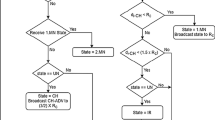Abstract
Wireless Sensor Networks for Rainfall Monitoring (RM-WSNs) is a sensor network for the large-scale regional and moving rainfall monitoring, which could be controlled deployment. Delivery delay and cross-cluster calculation leads to information inaccuracy by the existing dynamic collaborative self-organization algorithm in WSNs. In this letter, a Local Dynamic Cluster Self-organization algorithm (LDCS) is proposed for the large-scale regional and moving target monitoring in RM-WSNs. The algorithm utilizes the resource-rich node in WSNs as the cluster head, which processes target information obtained by sensor nodes in cluster. The cluster head shifts with the target moving in chance and re-groups a new cluster. The target information acquisition is limited in the dynamic cluster, which can reduce information across-clusters transfer delay and improve the real-time of information acquisition. The simulation results show that, LDCS can not only relieve the problem of “too frequent leader switches” in IDSQ, also make full use of the history monitoring information of target and continuous monitoring of sensor nodes that failed in DCS.
Similar content being viewed by others
References
Yan Xijun, Lu Limei, and Xu Lizhong. The application of wireless sensor network in the irrigation area automatic system. International Conference on Networks Security, Wireless Communications and Trusted Computing, NSWCTC’09, Center of Computer Network, Huazhong University of Science and Technology, China, April 25–26, 2009, 21–24.
I. F. Akyildiz, W. Su, Y. Sankarasubramaniam, et al.. A survey on sensor networks. Communications Magazine, 40(2002)8, 102–114.
W. B. Heinzelman, A. P. Chandrakasan, H. Balakrishnan, et al.. An application-specific protocol architecture for wireless microsensor networks. IEEE Transactions on Wireless Communications, 1(2002)4, 660–670.
Shen Bo, Zhang Shiyong, and Zhong Yiping. Cluster-based routing protocols for wireless sensor networks. Journal of Software, 17(2006)7, 1588–1600 (in Chinese). 沈波, 张世永, 钟亦平. 无线传感器网络分簇路由协议. 软件学报, 17(2006)7, 1588–1600.
Wang Huibin, Yu Xian, and Kong Deli. Route protocol of wireless sensor networks based on dynamic setting cluster. Proceedings of the IEEE International Conference on Information Acquisition, Cheju Island, South Korea, June 9–11, 2007, 112–117.
Yuanzhu P. Chen, A. I. Liestman, and Jiangchuan Liu. Energy efficient data aggregation hierarchy for wireless sensor networks. The Second International Conference on Quality of Service in Heterogeneous Wired/Wireless Networks, Orlando, Florida, USA, 2005, 7–15.
Li Li and Wen Xiangming. Energy efficient optimization of clustering algorithm in wireless sensor network. Journal of Electronics & Information Technology, 30(2008)4, 966–969 (in Chinese). 李莉, 温向明. 无线传感器网络中分簇算法能量有效性分析. 电子与信息学报, 30(2008)4, 966–969.
Zhao Feng, Liu Jie, and Liu Juan. Information-driven dynamic sensor collaboration for tracking applications. IEEE Signal Processing Magazine, 19(2002)2, 61–72.
Zhao Feng, Liu Jie, Liu Juan, et al.. Collaborative signal and information processing: an information-directed approach. Proceedings of the IEEE, 91(2003)8, 1199–1209.
Wang Rui, Liang Yan, Pan Quan, and Cheng Yongmei. A self-organization algorithm in wireless sensor networks. Acta Automatica Sinica, 32(2006)5, 829–833 (in Chinese). 王睿, 梁彦, 潘泉, 等. 无线传感器网络信息感知中的自组织算法. 自动化学报, 32(2006)5, 829–833.
M. Gastpar and M. Vetterli. Source-channel communication in sensor networks. Lecture Notes in Computer Science, 2634(2003), 162–177.
J. O. Berger, V. De Oliveira, and B. Sansó. Objective Bayesian analysis of spatially correlated data. Journal of the American Statistical Association, 96(2001)456, 1361–1374.
J. Zhao and R. Govindan. Understanding packet delivery performance in dense wireless sensor networks. ACM, New York, NY, USA, 2003, 1–13.
Li Hong, Yu Hongyi, and Liu A-na. A tree based data collection scheme for wireless sensor network. Journal of Electronics & Information Technology, 29(2007)7, 1633–1637 (in Chinese). 李宏, 于宏毅, 刘阿娜. 一种基于树的无线传感器网络数据收集方法. 电子与信息学报, 29(2007)7, 1633–1637.
J. P. Sheu, P. K. Hung, and C. S. Hsu. Scheduling of broadcasts in multihop wireless networks. The Electrical Engineering Handbook Series, Boca Raton, FL, USA, CRC Press, 2003, 483–495.
Yang Haibo and Chen Yourong. An object tracking technique in wireless sensor network based on prediction. Computer Simulation, 25(2008)8, 118–122 (in Chinese). 杨海波, 陈友荣. 一种基于预测的无线传感器网络目标跟踪技术. 计算机仿真, 25(2008)8, 118–122.
Author information
Authors and Affiliations
Corresponding author
Additional information
Supported by the Key Projection of Science and Technology Research of Ministry of Education of China (107057) and the Science & Technology Fund for Students of Hohai University (K200803).
Communication author: Wang Huibin, born in 1967, Ph.D., Associate Professor.
About this article
Cite this article
Wang, H., Xu, L., Xiao, X. et al. A local dynamic cluster self-organization algorithm in wireless sensor networks for rainfall monitoring. J. Electron.(China) 27, 279–288 (2010). https://doi.org/10.1007/s11767-010-0323-5
Received:
Revised:
Published:
Issue Date:
DOI: https://doi.org/10.1007/s11767-010-0323-5




